Welcome to our free classical music site

Do you write about classical music? Are you a blogger? Want to team up with Classical Connect? Send us a message, let's talk!

Do you write about classical music? Are you a blogger? Want to team up with Classical Connect? Send us a message, let's talk!
May 5, 2014. Brahms and Tchaikovsky. Two great composers share a birthday this week: Johannes Brahms and Pyotr (Peter Ilyich) Tchaikovsky were born on May 7th, the former in 1833, the latter seven years later, in 1840. We feel that in the past years we’ve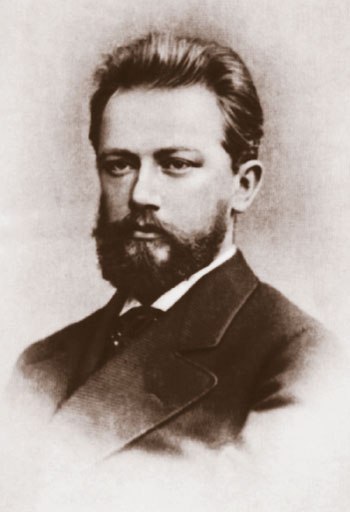 shortchanged Tchaikovsky a bit, so this year we’ll dedicate an entry to him. Tchaikovsky was born in Votkinsk, a small town about 800 miles east of Moscow. His father,an engineer at the local ironworks, was from a line of Cossaks named Chaika ("seagull" in Russian). His mother, Alexandra, née d'Assier, was French on her father’s side. A piano teacher was hired when Tchaikovsky was five; he proved to be a quick learner but didn’t exhibit any special talents. His music studies ended soon after: when Tchaikovsky was 10, his parents decided to send him to St-Petersburg to the Imperial School of Jurisprudence, to be prepared for a more practical career. He started at the boarding prep school and entered the main school at the age of 12. Tchaikovsky was very close to his mother and suffered from their separation. When he was 14, Alexandra died of cholera; that traumatic event affected Tchaikovsky for the rest of his life.
shortchanged Tchaikovsky a bit, so this year we’ll dedicate an entry to him. Tchaikovsky was born in Votkinsk, a small town about 800 miles east of Moscow. His father,an engineer at the local ironworks, was from a line of Cossaks named Chaika ("seagull" in Russian). His mother, Alexandra, née d'Assier, was French on her father’s side. A piano teacher was hired when Tchaikovsky was five; he proved to be a quick learner but didn’t exhibit any special talents. His music studies ended soon after: when Tchaikovsky was 10, his parents decided to send him to St-Petersburg to the Imperial School of Jurisprudence, to be prepared for a more practical career. He started at the boarding prep school and entered the main school at the age of 12. Tchaikovsky was very close to his mother and suffered from their separation. When he was 14, Alexandra died of cholera; that traumatic event affected Tchaikovsky for the rest of his life.
Practically nothing at that time indicated Tchaikovsky’s talent: he took some additional piano lessons but his teacher told his father that he doesn’t see a future of a composer or performer for his pupil. Still, upon graduating and accepting a low-level position with the Ministry of Justice, Tchaikovsky decided to take classes in music theory organized by the Russian Music Society. Anton Rubinstein, ten years older than Tchaikovsky and by then already famous as a pianist and composer, was a founder. In 1862 these music classes evolved into a real conservatory, with Rubinstein at the helm. Tchaikovsky enrolled as a member of the first class, but still held on to his job at the Ministry, not sure about his musical future. In three years of studying at the Conservatory, his musical talent greatly evolved; Rubinstein would later call him a “genius.” That didn’t stop the conservative Rubinstein from criticizing Tchaikovsky’s first serious compositions. Symphony no. 1 (Winter Dreams) was one of such pieces. Tchaikovsky composed it in 1866. By then, he had graduated from the Conservatory and was having a hard time: César Cui, one of The Five, harshly criticized the cantata he wrote for graduation. In addition, the composition process was difficult and slow. When Tchaikovsky showed him the score, Rubinstein suggested significant changes. And even after Tchaikovsky accepted them, he remained dissatisfied with the results. In the end he refused to perform it altogether, and the Symphony was premiered two years later in Moscow, without Rubinstein’s alterations. It’s dedicated to Nikolai Rubinstein, Anton’s brother, a talented pianist and Tchaikovsky’s dear friend. Here it is, probably the first important symphony in the history of Russian music. It is performed by the Berlin Philharmonic Orchestra under the direction of Herbert von Karajan.
At that time, Nikolai Rubinstein, with his brother Anton’s help and Prince Nikolai Troubetzkoy’s money, was organizing a conservatory in Moscow. He offered Tchaikovsky a professorship, which Tchaikovsky accepted, even though the salary was very modest. During those years Tchaikovsky continued to compose. The opera The Voyeboda was completed in 1868, and several piano pieces followed. String Quartet no. 1 was written in 1871 and the Snow Maiden two years later. He was also making money by writing articles in the newspaper "Russian Vedomosty." One of the composers he did not appreciate at all was Johannes Brahms. Tchaikovsky called him mediocre, pretentious, a pedestrian composer – all that after reading the piano transcriptions of Brahms’s symphonies, two piano concertos, the violin concerto and a number of chamber pieces. To appreciate the difference in insights of Tchaikovsky the composer and Tchaikovsky the critic, let’s listen to one of these scorned pieces, Brahms’s Symphony no. 1. Tchaikovsky may have been right that some of the Brahms’s writing is pompous and pretentious but still it’s music of genius, and by any measure much better than Tchaikovsky’s own pleasant but not terribly consequential first symphony. As the Tchaikovsky’s symphony above, this symphony is performed, live in this case, by the Berlin Philharmonic, Herbert von Karajan conducting.
PermalinkApril 28, 2014. Alessandro Scarlatti and Giacomo Carissimi. Alessandro Scarlatti’s birthday is this week. He was born on May 2nd of 1660 in Palermo, Sicily. When he was 12, he moved to Rome, and soon after found the patronage of Queen Christina. In 1684 Scarlatti moved to Naples, where he became the maestro di capelle at the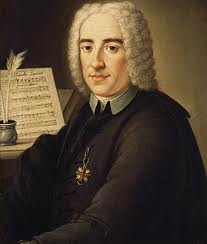 royal court (we wrote about this period of his life at length a year ago). He stayed in Naples till 1702 and then moved to Florence. He wrote four operas for the Prince Ferdinando III de Medici and then moved back to Rome.. By 1707 he was working for the Cardinal Ottoboni, the great patron of arts and music. That year he wrote the opera Il Mitridate Eupatore. It was premiered in Venice and was received poorly. Now it is considered (and is) one of Scarlatti’s finest. The role of Mitridate was written for a castrato but these days it’s sung by sopranos, and so is another leading role, that of Mitridate’s sister, Laodice. Here’s her aria Di Mitridate genitor... Dolce stimola al tuo bel care, sung by the incomparable Joan Sutherland. We know that in a few years Scarlatti would be eclipsed by the young Handel, but it seems that this music is on the level of the greatest arias Handel ever wrote. Edmond Appia conducts the BBC orchestra. And here’s another one of Laodice’s arias, Dolce cara allegrezza inaudita, from the same production (we have to concede that the voice of La Stupenda brings all music she sings to a different level). And of course we should remember the wonderful aria Cara tomba of the protagonist, Mitridate. It’s beautifully sung by the German coloratura Simone Kermes.
royal court (we wrote about this period of his life at length a year ago). He stayed in Naples till 1702 and then moved to Florence. He wrote four operas for the Prince Ferdinando III de Medici and then moved back to Rome.. By 1707 he was working for the Cardinal Ottoboni, the great patron of arts and music. That year he wrote the opera Il Mitridate Eupatore. It was premiered in Venice and was received poorly. Now it is considered (and is) one of Scarlatti’s finest. The role of Mitridate was written for a castrato but these days it’s sung by sopranos, and so is another leading role, that of Mitridate’s sister, Laodice. Here’s her aria Di Mitridate genitor... Dolce stimola al tuo bel care, sung by the incomparable Joan Sutherland. We know that in a few years Scarlatti would be eclipsed by the young Handel, but it seems that this music is on the level of the greatest arias Handel ever wrote. Edmond Appia conducts the BBC orchestra. And here’s another one of Laodice’s arias, Dolce cara allegrezza inaudita, from the same production (we have to concede that the voice of La Stupenda brings all music she sings to a different level). And of course we should remember the wonderful aria Cara tomba of the protagonist, Mitridate. It’s beautifully sung by the German coloratura Simone Kermes.
Giacomo Carissimi was 55 years older than Scarlatti. Whereas Scarlatti worked when Baroque was already a highly developed, established style, Carissimi was an early Baroque composer. He was born around April 18th of 1605 (that’s the day of his baptism) in Marino, near Rome. We know that at the age of 20 he became a maestro di capelle in Assisi. In 1628 he moved back to Rome to assume the same position at Collegium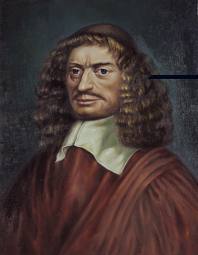 Germanicum, the post held by many great composers, Tomás Luis de Victoria one of them. He stayed at the College and it’s church, Sant'Apollinare, for the rest of his life, even though he received invitations from many places, including the offer to take over Claudio Monteverdi’s position at San Marco in Venice. Carissimi was one of the first composers to develop the musical form of oratorio based on the text from an episode in the Bible, with soloists, choir, and the Narrator, whose recitatives linked the story together. This genre has stayed popular ever since. It reached its pinnacle with Johann Sebastian Bach (the Passions) and Handel (Messiah), but Mendelssohn in the 19th century, and both Stravinsky and Penderecki in the 20th produced masterpieces. One of Carissimi’s best-known oratorios is Jephte, written around 1650. It’s based on a story from the Book of Judges. You can hear it in the performance by the ensemble Cantus Cölln, Konrad Junghänel conducting. Carissimi, who never wrote operas, was instrumental in developing cantatas, which are in many ways similar to shorter operas. He died on January 12th, 1674. By then, the Baroque style was predominant, in no small measure propelled by Carissimi’s work.
Germanicum, the post held by many great composers, Tomás Luis de Victoria one of them. He stayed at the College and it’s church, Sant'Apollinare, for the rest of his life, even though he received invitations from many places, including the offer to take over Claudio Monteverdi’s position at San Marco in Venice. Carissimi was one of the first composers to develop the musical form of oratorio based on the text from an episode in the Bible, with soloists, choir, and the Narrator, whose recitatives linked the story together. This genre has stayed popular ever since. It reached its pinnacle with Johann Sebastian Bach (the Passions) and Handel (Messiah), but Mendelssohn in the 19th century, and both Stravinsky and Penderecki in the 20th produced masterpieces. One of Carissimi’s best-known oratorios is Jephte, written around 1650. It’s based on a story from the Book of Judges. You can hear it in the performance by the ensemble Cantus Cölln, Konrad Junghänel conducting. Carissimi, who never wrote operas, was instrumental in developing cantatas, which are in many ways similar to shorter operas. He died on January 12th, 1674. By then, the Baroque style was predominant, in no small measure propelled by Carissimi’s work.
PermalinkApril 21, 2014. Prokofiev and Torelli. Sergei Prokofiev’s birthday is this week: he was born on April 23rd (new style) of 1891. Prokofiev was not only a composer of huge talent, he was also a wonderful pianist (his recording of Mussorgsy’s Pictures at an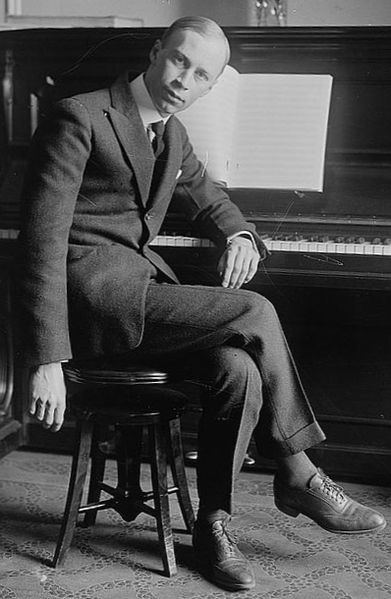 Exhibition, for example, is one of the best). He premiered all but one of his piano concertos, even though some of them are among the most difficult works for the instrument (his concerto no. 4, for the left hand and written for Paul Wittgenstein who lost his right arm during WWI, was never performed during Prokofiev’s lifetime). Prokofiev wrote his first concerto in 1911-1912, while still at studying at the St-Petersburg Conservatory. The premier took place in Moscow in August of 1912. Two years later he submitted the same work for the Anton Rubinstein competition, which was to determine the best pianist in the graduating class. At the time Prokofiev joked that as the work was new, the judges wouldn’t know whether he was playing it right or not. We don’t know if that was the reason, but Prokofiev indeed won the competition, even if Glazunov, the head of the jury, was rather reluctant to award him the first prize. The first piano concerto is in one movement and the shortest of the five he’d eventually write. It’s full of energy and youthful charisma. Here it is, in the 1952 performance by Sviatoslav Richter with what used to be called the Moscow Youth Symphony, the orchestra, which one year later became the Moscow Philharmonic Orchestra. Kirill Kondrashin, its music director of many years, is conducting.
Exhibition, for example, is one of the best). He premiered all but one of his piano concertos, even though some of them are among the most difficult works for the instrument (his concerto no. 4, for the left hand and written for Paul Wittgenstein who lost his right arm during WWI, was never performed during Prokofiev’s lifetime). Prokofiev wrote his first concerto in 1911-1912, while still at studying at the St-Petersburg Conservatory. The premier took place in Moscow in August of 1912. Two years later he submitted the same work for the Anton Rubinstein competition, which was to determine the best pianist in the graduating class. At the time Prokofiev joked that as the work was new, the judges wouldn’t know whether he was playing it right or not. We don’t know if that was the reason, but Prokofiev indeed won the competition, even if Glazunov, the head of the jury, was rather reluctant to award him the first prize. The first piano concerto is in one movement and the shortest of the five he’d eventually write. It’s full of energy and youthful charisma. Here it is, in the 1952 performance by Sviatoslav Richter with what used to be called the Moscow Youth Symphony, the orchestra, which one year later became the Moscow Philharmonic Orchestra. Kirill Kondrashin, its music director of many years, is conducting.
Prokofiev started working on his second piano concerto almost immediately after completing the first one, in 1912. He finished it in 1913 and dedicated it to Maximilian Schmidthof, his friend from the Conservatory, who committed suicide in the spring of that year. The work was premiered in Pavlovsk, outside of St.-Petersburg, in August, in a concert for the Russian Musical Society. The public was scandalized. Viacheslav Karatygin, a critic, reported that the concerto “left listeners frozen with fright, hair standing on end.” Another critic called it “a cacophony of sounds that has nothing in common with civilized music.” During the Revolution of 1917 the orchestral score was lost, and Prokofiev rewrote it in 1923, changing it considerably in the process. By then Prokofiev had emigrated from Russia, married a Spanish singer, and was living in Paris. He played at the second premier in Paris in 1924, with Serge Koussevitzky conducting, and the reception was not much better than that of 10 years earlier in Russia. These days it’s considered a classic. The concerto is technically extremely challenging. Prokofiev himself stopped playing it shortly after the premier. Sviatoslav Richter never played Piano concerto no. 2, even though he considered it one of the most fundamental in all piano literature. Martha Argerich didn’t play it either. We’ll hear it in the performance by Evgeny Kissin, technically one of the most gifted pianists of his generation; the Philharmonia Orchestra is lead by Vladimir Ashkenazy.
Giuseppe Torelli, a minor Baroque composer, was born on April 22nd, 1658 in Verona. He studied the violin, but ended up composing a large number of trumpet concertos (he also wrote many concerti grosso). Here’s one of them, a very pleasant Trumpet concerto in D Major. Alison Balsom is playing the trumpet, the Deutsche Kammerphilharmonie Bremen is lead by Thomas Klug.
PermalinkApril 20, 2014. Happy Easter to all!
Here, to celebrate, is one of Bach’s Easter cantatas, Christ lag in Todes Banden, BWV 4. Concentus musicus Wien is conducted by Nikolaus Harnoncourt.
The fresco, above, The Resurrection, is by Piero della Francesca and was painted around 1463-1465. Aldous Huxley called it “the greatest picture in the world.”Permalink
April 14, 2014. Ockeghem. Johannes Ockeghem was one of the greatest composers of the Franco-Flemish school, and, therefore, one of the greatest composers of the early Renaissance, as Burgundians dominated the European musical scene in the 15th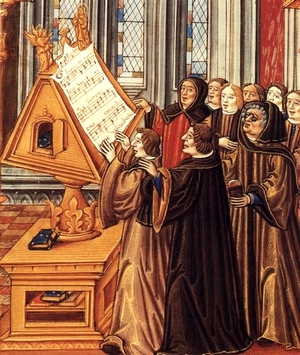 century. The date of Ockeghem’s birth is very much in doubt, some researchers suggest 1410, other – 1425. He was probably born in the town of Saint-Ghislain, not far from Mons, the capital of the county of Hainaut. Two famous composers, Gilles Binchois some years earlier and Orlando di Lasso a century later were born in Mons. It’s possible that Ockenghem studied with Binchois, and it’s even more probable that they met at the Burgundian court later on. In 1443 Ockeghem was a chorister in Antwerp, and between 1446 and 1448 served at the court of Charles I, Duke of Bourbon. The dukes were of an old noble family that would eventually rule all of France (king Louis XIV was a Bourbon), but at the time of Ockeghem the French kings came from the House of Valois. Ockeghem would serve them as well: he moved to Paris around 1452 and was hired as a singer at the court of King Charles VII (according to contemporaries, Ockeghem had a beautiful bass voice). Several years later he was given the title of Maistre de chapelle de chant du roy. He also became a canon of the cathedral of Notre Dame de Paris. In 1460 Gilles Binchois died in Soignies and Ockeghem wrote a “Déploration” (Lamentation) on his death. You can listen to it hear. The Laudantes Consort is led by Guy Janssens.
century. The date of Ockeghem’s birth is very much in doubt, some researchers suggest 1410, other – 1425. He was probably born in the town of Saint-Ghislain, not far from Mons, the capital of the county of Hainaut. Two famous composers, Gilles Binchois some years earlier and Orlando di Lasso a century later were born in Mons. It’s possible that Ockenghem studied with Binchois, and it’s even more probable that they met at the Burgundian court later on. In 1443 Ockeghem was a chorister in Antwerp, and between 1446 and 1448 served at the court of Charles I, Duke of Bourbon. The dukes were of an old noble family that would eventually rule all of France (king Louis XIV was a Bourbon), but at the time of Ockeghem the French kings came from the House of Valois. Ockeghem would serve them as well: he moved to Paris around 1452 and was hired as a singer at the court of King Charles VII (according to contemporaries, Ockeghem had a beautiful bass voice). Several years later he was given the title of Maistre de chapelle de chant du roy. He also became a canon of the cathedral of Notre Dame de Paris. In 1460 Gilles Binchois died in Soignies and Ockeghem wrote a “Déploration” (Lamentation) on his death. You can listen to it hear. The Laudantes Consort is led by Guy Janssens.
After the death of Charles in 1461, Ockeghem continued at the court of his son, King Louis XI. By 1475 the One Hundred Year’s War was over. Louis XI signed a treaty with the English and went to battle his other sworn enemy, the Burgundians. Two years later Charles the Bold, the Duke of Burgundy, was killed in a battle, and Louis XI took possession of many of the Duchy’s territories, including Burgundy itself. Lois XI died in 1483; Ockeghem continued at the court of Charles VIII, but eventually left Paris. He spent some time in Bruges and then went to Tours, where he held a prestigious position of the treasurer of the St.-Martin Cathedral. He died in Tours in 1497. Many “laments” were composed at his death, just as he did when Binchois died. The most famous of these funeral chansons was written by Josquin des Prez. You can listen to it hear, in the performance by Laudantes Consort with Guy Janssens.
Compared to his predecessors, Guillaume Dufay, John Dunstaple or Gilles Binchois, Ockeghem’s textures seem to be richer and more sonorous. He wasn’t a very prolific composer: his extant output consists of 14 masses, 10 motets, and several chansons. Here’s Kyrie from his L'homme armé Mass. It’s preceded by the famous tune itself, which is later user throughout the mass, usually in the tenor part and slow development, so it’s not easy to hear it directly. Oxford Camerata is lead by Jeremy Summerly. And hear’s an amazing motet Deo gratias, for four nine-part choruses – thirty-six parts altogether, in a virtuoso performance by the Huelgas Ensemble. It’s lead by Paul van Nevel.
The anonymous picture above is often considered a portrait of Ockeghem with members of the choir. He’s the one wearing the glasses!
PermalinkApril 7, 2014. Rachmaninov and Stradella. We missed the birthday of Sergei Rachmaninov, and probably by more than one week: according to the new calendar, he was born on April 1st of 1873 - but back then Russia was still using the Julian calendar, so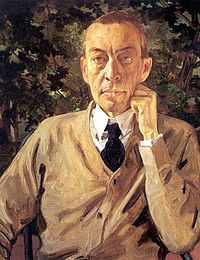 contemporary documents state that Rachmaninov was born on March 20th. As talented as he was anachronistic, he wrote 19th century music well into the 20th. But do we really mind if so much of it was so good? Rachmaninov’s life was divided in two by the October revolution: he left Russia at the end of 1917 for a concert tour and never returned. On November 1, 1918, after a series of concerts in Scandinavia, he and his family boarded a ship to New York. He lived in the United States for the rest of his life (Rachmaninov died in 1943 in his home in Beverly Hills). In this second part of his life, he concretized a lot (he was, after all, one of the greatest pianist of the 20th century) and composed rather little. In 26 years he wrote just five major compositions: Piano Concerto no. 4, Variations on a Theme of Corelli, Rhapsody on a Theme of Paganini for piano and orchestra, Symphony no. 3 and Symphonic Dances. The Russian half of his life was much more productive: three piano concertos, two symphonies and the symphonic poem Isle of the Dead, several operas (none of them very successful, except probably Aleko, which he wrote as a graduation work at the Moscow Conservatory) and a large number of piano pieces. The Piano Concerto no. 3 was written in the summer of 1909 during his stay at the much-loved family estate of Ivanovka (it was lost during the Revolution). One of Rachmaninov’s masterpieces, it’s technically one of the most difficult compositions in the piano repertoire. Rachmaninov brought it to his tour of the United States, and premiered the work in New York on November 28, 1909. Walter Damrosch conducted the New York Symphony orchestra. Several weeks later Rachmaninov played it again, this time with Gustav Mahler conducting. We’ll hear it in the 1955 performance by Emil Gilels, one of the greatest interpreters of this concerto. André Cluytens is conducting Orchestre de la Société des Concerts du Conservatoire. The portrait of Rachmaninov, above, was painted by the Russian artist Konstantin Somov in 1925.
contemporary documents state that Rachmaninov was born on March 20th. As talented as he was anachronistic, he wrote 19th century music well into the 20th. But do we really mind if so much of it was so good? Rachmaninov’s life was divided in two by the October revolution: he left Russia at the end of 1917 for a concert tour and never returned. On November 1, 1918, after a series of concerts in Scandinavia, he and his family boarded a ship to New York. He lived in the United States for the rest of his life (Rachmaninov died in 1943 in his home in Beverly Hills). In this second part of his life, he concretized a lot (he was, after all, one of the greatest pianist of the 20th century) and composed rather little. In 26 years he wrote just five major compositions: Piano Concerto no. 4, Variations on a Theme of Corelli, Rhapsody on a Theme of Paganini for piano and orchestra, Symphony no. 3 and Symphonic Dances. The Russian half of his life was much more productive: three piano concertos, two symphonies and the symphonic poem Isle of the Dead, several operas (none of them very successful, except probably Aleko, which he wrote as a graduation work at the Moscow Conservatory) and a large number of piano pieces. The Piano Concerto no. 3 was written in the summer of 1909 during his stay at the much-loved family estate of Ivanovka (it was lost during the Revolution). One of Rachmaninov’s masterpieces, it’s technically one of the most difficult compositions in the piano repertoire. Rachmaninov brought it to his tour of the United States, and premiered the work in New York on November 28, 1909. Walter Damrosch conducted the New York Symphony orchestra. Several weeks later Rachmaninov played it again, this time with Gustav Mahler conducting. We’ll hear it in the 1955 performance by Emil Gilels, one of the greatest interpreters of this concerto. André Cluytens is conducting Orchestre de la Société des Concerts du Conservatoire. The portrait of Rachmaninov, above, was painted by the Russian artist Konstantin Somov in 1925.
The Italian Baroque composer Alessandro Stradella was born on April 3rd, 1639. The legends surrounding his life are spectacular, even if we cannot vouch for their veracity. He was of noble descent, probably a Tuscan. In 1669 he moved to Rome, where Queen Cristina of Sweden became his benefactor (later she would offer patronage to Arcangelo Corelli, Alessandro Scarlatti and many other musicians).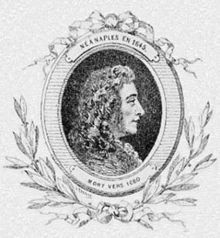 He attempted to embezzle money from the Church, had multiple affairs and eventually had to leave Rome. He went to Venice where Doge Alvise Contarini hired him as a music tutor to his mistress, Agnese Van Uffele. Uffele and Stradella fell in love and fled to Turin. Contarini sent two assassins after Stradella; they found and attacked him but Stradella survived. He then fled to Genoa where he continued composing and cuckolding local nobility. He met his end at the hands of yet another pair of assassins, this time craftier ones: they stabbed him to death in the center of Genoa, on Piazza Banchi. Stradella was 42. The murder was never solved but it was rumored that a local nobleman hired the killers. While engaged in all these shenanigans, Stradella also found time to compose music: he wrote almost 300 compositions, operas, oratorios, sonatas and other incidental pieces. His “sonatas” for solo instruments and a small orchestras became precursors of concerto grosso, later perfected by Corelli. Here is one of such sonatas, Sonata di viole. It’s performed by Orchestra Barocca della Civica Scuola di Musica di Milano, Enrico Gatti conducting.Permalink
He attempted to embezzle money from the Church, had multiple affairs and eventually had to leave Rome. He went to Venice where Doge Alvise Contarini hired him as a music tutor to his mistress, Agnese Van Uffele. Uffele and Stradella fell in love and fled to Turin. Contarini sent two assassins after Stradella; they found and attacked him but Stradella survived. He then fled to Genoa where he continued composing and cuckolding local nobility. He met his end at the hands of yet another pair of assassins, this time craftier ones: they stabbed him to death in the center of Genoa, on Piazza Banchi. Stradella was 42. The murder was never solved but it was rumored that a local nobleman hired the killers. While engaged in all these shenanigans, Stradella also found time to compose music: he wrote almost 300 compositions, operas, oratorios, sonatas and other incidental pieces. His “sonatas” for solo instruments and a small orchestras became precursors of concerto grosso, later perfected by Corelli. Here is one of such sonatas, Sonata di viole. It’s performed by Orchestra Barocca della Civica Scuola di Musica di Milano, Enrico Gatti conducting.Permalink